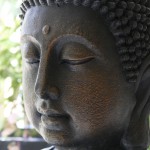 The Buddha said “Life means suffering”, but every mother thinks, “just not my kids, leave them out”.
The Buddha said “Life means suffering”, but every mother thinks, “just not my kids, leave them out”.
When my children were growing up, my first and immediate response to thier physical or emotional pain was, of course, to prevent or cure it. As they grew older there were more hurts that I couldn’t prevent and couldn’t fix. I also learned that there were times when my attempts to take away their pain did more harm than good.
This past week I watched my grown son’s grieve deeply and profoundly. As I walked through the first shock and then all the rituals that surround a death, I remembered that being with a child in pain requires skills, not just empathy.
Empathy is the identification with another’s feelings which in some people and some situations can lead to empathic distress. When we experience this distress, say when our children cry or get their first shots at the pediatrician’s office, we are wired to comfort and protect. But what happens when we experience empathic distress, and are helpless to do anything? We may keep trying to fix, which creates more distress or withdraw and numb out. So, we need to develop true compassion, which is empathy with an acceptance of reality, a wish for an end to the pain and staying present with our child.
There are some practices that are profoundly helpful. The one I came back to again and again, all this week, was the ancient practice of Tonglen, or giving and receiving. We can incorporate this into our yoga or meditation practice and into our day to day lives with our children. As we strengthen our capacity to stay present with our children, as they go through the bumps and bruises of childhood, they learn to cope and comfort themselves, and they feel deeply comforted by us. Knowing when to step in and when to step back is never easy, but the less overwhelmed we are by distress the easier it is to figure out. We can keep our own fight or flight reaction simmered down enough to be helpful.
On The Mat
You can do this either sitting, before or after yoga, or during asana practice. Tonglen is simple, you breathe in pain and suffering, rather than resisting it, and you breathe out compassion for yourself, your child and all others who are suffering. I start by bringing my attention to my feet and then doing a body scan to see where I am most tense. I breathe into the tension (which is usually the body’s attempt to fight off the pain) and breathe out from my heart, love and compassion. I sometimes add the words “may you be safe, may you be strong, may you feel loved”
It is a good idea to do this every day. It builds strength and is said to transform toxic pain into healing. Pema Chodrin has a simple page on the practice.
Use the tonglen practice to see how you can place the anger or the fear or the loneliness in a cradle of loving-kindness… -Pema Chödrön
Off The Mat
Whenever you sense your child or someone else in pain, (including yourself) before you decide if you can help, find your feet, breathe in their pain, breathe out a wish for relief. Then decide on a course of action. For me, this week, it meant a hand on a back, cooking a meal, helping to recall a healing memory, all while I breathed in and out, giving and receiving. I also accepted all the hugs I could.
I hope this practice helps you to feel confident that you will be able to stay present with your child even if you can’t take away their pain. Let me know what you think.
“May we all feel loved, may we all be safe, may we all heal.”
Leave a Reply